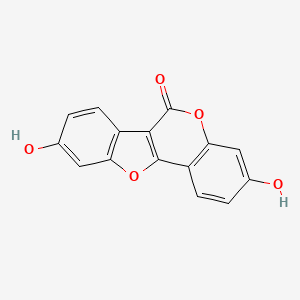| MeSH term | MeSH ID | Detail |
|---|---|---|
| Breast Neoplasms | D001943 | 24 associated lipids |
| Lupus Erythematosus, Systemic | D008180 | 43 associated lipids |
| Pancreatic Neoplasms | D010190 | 77 associated lipids |
| Colonic Neoplasms | D003110 | 161 associated lipids |
| Mammary Neoplasms, Experimental | D008325 | 67 associated lipids |
| Body Weight | D001835 | 333 associated lipids |
| Edema | D004487 | 152 associated lipids |
| Weight Gain | D015430 | 101 associated lipids |
| Endometriosis | D004715 | 29 associated lipids |
| Birth Weight | D001724 | 23 associated lipids |
COUMESTROL
COUMESTROL is a lipid of Polyketides (PK) class. Coumestrol is associated with abnormalities such as Infertility, Renal tubular disorder, Osteoporosis, Postmenopausal, Nodule and Central precocious puberty. The involved functions are known as Process, antagonists, Accident due to exposure to weather conditions, physiological aspects and Cell Proliferation. Coumestrol often locates in Blood, Body tissue, Reproductive system, Membrane and Myometrial. The associated genes with COUMESTROL are GAPDH gene, PPID gene, pyridinoline, NODAL gene and Nitrogen fixation gene. The related lipids are enterodiol. The related experimental models are Mouse Model.
Cross Reference
Introduction
To understand associated biological information of COUMESTROL, we collected biological information of abnormalities, associated pathways, cellular/molecular locations, biological functions, related genes/proteins, lipids and common seen animal/experimental models with organized paragraphs from literatures.
What diseases are associated with COUMESTROL?
COUMESTROL is suspected in Infertility, Renal tubular disorder, Osteoporosis, Postmenopausal, Nodule, Central precocious puberty and other diseases in descending order of the highest number of associated sentences.
Related references are mostly published in these journals:
| Disease | Cross reference | Weighted score | Related literature |
|---|
Possible diseases from mapped MeSH terms on references
We collected disease MeSH terms mapped to the references associated with COUMESTROL
PubChem Associated disorders and diseases
What pathways are associated with COUMESTROL
There are no associated biomedical information in the current reference collection.
PubChem Biomolecular Interactions and Pathways
Link to PubChem Biomolecular Interactions and PathwaysWhat cellular locations are associated with COUMESTROL?
Visualization in cellular structure
Associated locations are in red color. Not associated locations are in black.
Related references are published most in these journals:
| Location | Cross reference | Weighted score | Related literatures |
|---|
What functions are associated with COUMESTROL?
Related references are published most in these journals:
| Function | Cross reference | Weighted score | Related literatures |
|---|
What lipids are associated with COUMESTROL?
Related references are published most in these journals:
| Lipid concept | Cross reference | Weighted score | Related literatures |
|---|
What genes are associated with COUMESTROL?
Related references are published most in these journals:
| Gene | Cross reference | Weighted score | Related literatures |
|---|
What common seen animal models are associated with COUMESTROL?
Mouse Model
Mouse Model are used in the study 'Modulation of tumor formation and intestinal cell migration by estrogens in the Apc(Min/+) mouse model of colorectal cancer.' (Javid SH et al., 2005).
Related references are published most in these journals:
| Model | Cross reference | Weighted score | Related literatures |
|---|
NCBI Entrez Crosslinks
All references with COUMESTROL
Download all related citations| Authors | Title | Published | Journal | PubMed Link |
|---|---|---|---|---|
| pmid: | ||||
| Baker VA et al. | Safety evaluation of phytosterol esters. Part 1. Assessment of oestrogenicity using a combination of in vivo and in vitro assays. | 1999 | Food Chem. Toxicol. | pmid:10069478 |
| Patisaul HB et al. | Regulation of estrogen receptor beta mRNA in the brain: opposite effects of 17beta-estradiol and the phytoestrogen, coumestrol. | 1999 | Brain Res. Mol. Brain Res. | pmid:10101243 |
| Dopp E et al. | Modulation of the intracellular calcium level in mammalian cells caused by 17beta-estradiol, different phytoestrogens and the anti-estrogen ICI 182780. | 1999 | J. Steroid Biochem. Mol. Biol. | pmid:10215038 |
| Hunter DS et al. | Estrogen receptor activation via activation function 2 predicts agonism of xenoestrogens in normal and neoplastic cells of the uterine myometrium. | 1999 | Cancer Res. | pmid:10397250 |
| Ashby J et al. | Induction of hyperplasia and increased DNA content in the uterus of immature rats exposed to coumestrol. | 1999 | Environ. Health Perspect. | pmid:10504149 |
| Yamada T et al. | Effect of grinding with hydroxypropyl cellulose on the dissolution and particle size of a poorly water-soluble drug. | 1999 | Chem. Pharm. Bull. | pmid:10517010 |
| Yamada T et al. | Characterization of urinary metabolites of a new benzofuroquinoline derivative, 3,9-bis(N,N-dimethylcarbamoyloxy)-5 H-benzofuro[3,2-c]-quinoline-6-one (KCA-098), in dogs. | 1999 | Pharmazie | pmid:10522271 |
| Dixon-Shanies D and Shaikh N | Growth inhibition of human breast cancer cells by herbs and phytoestrogens. | 1999 Nov-Dec | Oncol. Rep. | pmid:10523716 |
| Sakabe K et al. | Inhibitory effect of natural and environmental estrogens on thymic hormone production in thymus epithelial cell culture. | 1999 | Int. J. Immunopharmacol. | pmid:10606005 |
